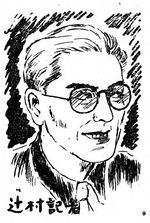Difference between revisions of "Takashi Tsujimura"
| Line 3: | Line 3: | ||
==Activities== | ==Activities== | ||
| − | [[:Category:Kinbakushi|Kinbakushi]] and [[:Category:Writer|Writer]]. It would not be an exaggeration to say that Takashi Tsujimura established modern Kinbaku Art. Introduced to [[Kitan Club]] ealier than [[Toshiyuki Suma]], he had contributed historical stories during [[Kitan Club]]'s pulp magazine period under the names <b> | + | [[:Category:Kinbakushi|Kinbakushi]] and [[:Category:Writer|Writer]]. It would not be an exaggeration to say that Takashi Tsujimura established modern Kinbaku Art. Introduced to [[Kitan Club]] ealier than [[Toshiyuki Suma]], he had contributed historical stories during [[Kitan Club]]'s pulp magazine period under the names <b>Kanrou Shindo</b> and <b>Takehiko Midori</b>. |
==Alternate Name(s)== | ==Alternate Name(s)== | ||
[http://smpedia.com/index.php?title=辻村隆 辻村隆](Japanese), [[Kanrou Shindo]], [[Takehiko Midori]]. | [http://smpedia.com/index.php?title=辻村隆 辻村隆](Japanese), [[Kanrou Shindo]], [[Takehiko Midori]]. | ||
| Line 11: | Line 11: | ||
1920s: Tsujimura remembers that as a 3rd or 4th grade elementary school student, he felt a strangely pleasant feeling being tied to a tree during a game of "cops and robbers"<ref name="robbers">Shimokawa, Koushi. "Eros of the Unforgiven: Tsujimura Takashi Reaches for the Limits." <i>Sankei Weekly</i> April 15, 1976: 159-161. Print.</ref>. | 1920s: Tsujimura remembers that as a 3rd or 4th grade elementary school student, he felt a strangely pleasant feeling being tied to a tree during a game of "cops and robbers"<ref name="robbers">Shimokawa, Koushi. "Eros of the Unforgiven: Tsujimura Takashi Reaches for the Limits." <i>Sankei Weekly</i> April 15, 1976: 159-161. Print.</ref>. | ||
| − | c.1937: | + | c.1937: The night before leaving for Manchuria, Tsujimura had his first bondage experience by tying his current lover (and future wife)<ref name="robbers">Shimokawa, Koushi. "Eros of the Unforgiven: Tsujimura Takashi Reaches for the Limits." <i>Sankei Weekly</i> April 15, 1976: 159-161. Print.</ref>. |
1948: Tsujimura became acquainted with [[Kitan Club]] magazine when he began working in a hardware store after his discharge from the military. He adopted the name [[Kanrou Shindo]] for his submitted works. | 1948: Tsujimura became acquainted with [[Kitan Club]] magazine when he began working in a hardware store after his discharge from the military. He adopted the name [[Kanrou Shindo]] for his submitted works. | ||
Revision as of 02:08, 19 January 2011
Tsujimura (辻村) family name, Takashi (隆) first name, (1921-1987)
Contents
Activities
Kinbakushi and Writer. It would not be an exaggeration to say that Takashi Tsujimura established modern Kinbaku Art. Introduced to Kitan Club ealier than Toshiyuki Suma, he had contributed historical stories during Kitan Club's pulp magazine period under the names Kanrou Shindo and Takehiko Midori.
Alternate Name(s)
辻村隆(Japanese), Kanrou Shindo, Takehiko Midori.
Biography
1921 (October): Takashi Tsujimura was born in Sakai.
1920s: Tsujimura remembers that as a 3rd or 4th grade elementary school student, he felt a strangely pleasant feeling being tied to a tree during a game of "cops and robbers"[1].
c.1937: The night before leaving for Manchuria, Tsujimura had his first bondage experience by tying his current lover (and future wife)[1].
1948: Tsujimura became acquainted with Kitan Club magazine when he began working in a hardware store after his discharge from the military. He adopted the name Kanrou Shindo for his submitted works.
1951: Tsujimura joined Kitan Club around this time. He began to write under the name Takashi Tsujimura by the January 1951 issue.
1951: In July, Tsujimura did the photography for nude photos. These were published in the January 1952 issue of Kitan Club[2].
1952: Tsujimura tied Ikuko Tachibana experimentally[2] that summer. After that he tied Tanako Kawabata for real[note 1].
1953: Tsujimura led "The Readers Roundtable on the Impulse Psychology Related to Mixed Pleasures Accompanying Torment" which appeared on p100 of the January Issue of Kitan Club.
1953: Credited for rope composition in the April and May issues of Kitan Club, and photography by Tetsuzo Tsukamoto.
1956: Tsujimura serialized "Conversational Waste Basket" from the April 1956 to January 1960 issues of Kitan Club.
1958: Tsujimura met Shigeru Kayama[3].
1964: "Salon Garakuki" appeared in Kitan Club beginning in May 1964 and lasting until the 105th episode in March 1973[note 2].
1964: "Camera Hunt" began its serialization in the November issue of Kitan Club." It lasted until March 1973.
1964: Tsujimura was responsible for the text of "'Relating Our Own Personal Experiences Completely Recorded in 'Kitan's Tales of Thirty Nine Nights' - A Round Table Discussion" which appeared on page 170 of the December issue of Kitan Club. Tsujimura, Tetsuzo Tsukamoto, Takashi Shima, Minoru Yoshida, and six fan readers attended the session in August.
1965: Tsujimura fell ill with diabetes[4] in May and took time off to recuperate until August.
Selected Works
References
- ↑ 1.0 1.1 Shimokawa, Koushi. "Eros of the Unforgiven: Tsujimura Takashi Reaches for the Limits." Sankei Weekly April 15, 1976: 159-161. Print.
- ↑ 2.0 2.1 Tsujimura, Takashi. "The Masochism of Female Models." Kitan Club Oct. 1954: 274. Print. Cite error: Invalid
<ref>tag; name "nude" defined multiple times with different content - ↑ From "Shigeru Kayama's World" (Site has since gone inactive). Web.
- ↑ Tsujimura, Takashi. "Salon Garakuki." Kitan Club May 1965: 14. Print
